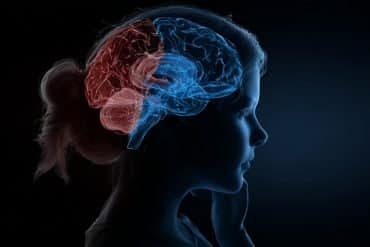Summary: Nonsuicidal self-harm is associated with neurocognitive impulsivity, especially in those who perceive negative emotional context of criticism in close relationships.
Source: Care New England
Are young adults who harm themselves more at risk for suicide? New research suggests there could be a connection under specific conditions associated with negative emotions.
Kenneth J.D. Allen, Ph.D., a postdoctoral research fellow in the Psychosocial Research Program at Butler Hospital and the Department of Psychiatry and Human Behavior at The Warren Alpert Medical School of Brown University, recently published several articles related to this important topic. His research suggests that nonsuicidal injury (NSSI), when people harm themselves without wanting to die, is associated with impulsive behavior, but only under specific conditions associated with negative emotions. Importantly, this research also identifies potential areas of treatment for a select group of individuals deemed as high-risk for suicide attempts.
Dr. Allen’s work was published in the peer-reviewed scientific journals Psychiatry Research (Frequency of nonsuicidal self-injury is associated with impulsive decision-making during criticism) and Behavior Therapy (Negative Emotional Action Termination (NEAT): Support for a cognitive mechanism underlying negative urgency in nonsuicidal self-injury). Dr. Allen’s work was completed with the support of his Ph.D. advisor Jill M. Hooley, D.Phil., who is affiliated with the Department of Psychology at Harvard University, and Heather T. Schatten, Ph.D., his co-mentor at Brown and Butler.
“People who self-injure, both more frequently and more recently, also make more impulsive choices when experiencing distress than those who self-injure less frequently and/or less recently,” said Dr. Allen.
“Importantly, this suggests the response to actual, perceived, or even self-criticism may be a promising treatment target, particularly for those at highest risk of future suicide attempts.”
Common examples of NSSI include cutting, burning, or hitting oneself. NSSI is common, especially among adolescents and young adults, even those without any diagnosable psychiatric conditions. While NSSI occurs without the intent of suicide, it is also one of the strongest predictors of future attempted suicide, so determining shared and distinct factors involved in nonsuicidal and suicidal forms of self-injury is critical.
Dr. Allen explained that while NSSI without suicidal intent may be a common behavior, the potential for serious consequences is significant, as research suggests these events are equivalent to prior suicide attempts in predicting future suicidal behavior.
“The clinical implications of this research could be substantial,” said Dr. Allen. “When and where the NSSI occurs in conjunction with negative mood and accompanying impulse control problems might inform assessment, treatment, and prevention of both NSSI and suicide, which is really what we’re here for.”
The published research shows the results of new laboratory tasks created by Dr. Allen and his colleagues addressing the discrepancy between self-reported impulsivity in people who engage in NSSI and their lack of impulsive behavior on existing laboratory tasks. The impact of this indicates that NSSI is associated with impulsive behavior, but only under specific conditions associated with negative emotions.

Although previous studies did not identify impulse control deficits in NSSI, Dr. Allen’s research demonstrates that people who self-injure have more difficulty controlling impulses directly motivated by negative emotions such as anxiety, anger, and sadness. Dr. Allen’s studies suggest that difficulty controlling impulses motivated by distress might help explain the link between NSSI and future suicide. This impairment is specific to negative emotional action termination, or the final stage of response inhibition, meaning that such individuals might only act impulsively once their negative feelings reach a certain level of intensity.
“Therapeutic interventions focusing on increasing ‘mindfulness’ could be particularly useful in helping individuals become aware of their emotions and accompanying urges before they become overwhelming and reach this breaking point,” said Dr. Allen. “Ultimately, our findings suggest that once someone gives in to an impulsive urge to self-injure, they may find it especially difficult to stop, whereas if that person can catch this urge early on, they may be able to choose a more adaptive strategy to reduce their unpleasant emotional state, such as exercising or listening to music.”
Source:
Care New England
Media Contacts:
Jeremy Milner – Care New England
Image Source:
The image is in the public domain.
Original Research: Closed access
“Negative Emotional Action Termination (NEAT): Support for a Cognitive Mechanism Underlying Negative Urgency in Nonsuicidal Self-Injury” Behavior Therapy Kenneth J. D. Allen, Jill M. Hooley doi:10.1016/j.beth.2019.02.001
Open access
“Frequency of nonsuicidal self-injury is associated with impulsive decision-making during criticism”
Psychiatry Research, Volume 271, January 2019, Pages 68-75
Kenneth J. D. Allen, Kathryn R. Fox, Heather T. Schatten, Jill M. Hooley doi:10.1016/j.psychres.2018.11.022
Abstract
Negative Emotional Action Termination (NEAT): Support for a Cognitive Mechanism Underlying Negative Urgency in Nonsuicidal Self-Injury
Negative urgency, the self-reported tendency to act impulsively when distressed, increases risk for nonsuicidal self-injury (NSSI). NSSI is also associated with impaired negative emotional response inhibition (NERI), specifically negative emotional action termination (NEAT), a cognitive process theoretically related to negative urgency. We previously found that adults with NSSI history had difficulty inhibiting behavioral responses to affective images depicting negative content (but not positive or neutral images) in an Emotional Stop-Signal Task. We sought to replicate this finding, determine whether this deficit extends to negative emotional action suppression (NEAS; an earlier stage of NERI), and explore whether impairment in these two stages of emotional response inhibition helps explain the relationship between negative urgency and NSSI. Eighty-eight adults with NSSI history (n = 45) and healthy control participants (n = 43) without NSSI history or psychopathology completed a clinical interview, symptom inventories, an impulsivity questionnaire, and behavioral assays of early and late NERI (NEAS and NEAT, respectively). The NSSI group had worse NEAT than the control group in the Emotional Stop-Signal Task, but no group differences in NEAS were observed in an Emotional Go/No-go task. However, both early and late stages of NERI accounted for independent variance in negative urgency. We additionally found that NEAT explained variance in the association between negative urgency and NSSI. These results suggest that impulsive behavior in NSSI may involve specifically impaired inhibitory control over initiated negative emotional impulses. This deficit in late response inhibition to negative emotional stimuli might reflect a cognitive mechanism or pathway to elevated negative urgency among people who self-injure.
Abstract
Frequency of nonsuicidal self-injury is associated with impulsive decision-making during criticism
Research indicates that nonsuicidal self-injury (NSSI) is associated with impulsive traits, but not impulsive behavior on laboratory tasks, even in the context of negative mood. However, previous studies may not have induced forms of negative affect most relevant to NSSI. For example, evidence implicates both self-criticism and feeling criticized by others in NSSI engagement. We conducted two studies examining whether negative mood related to criticism increases impulsive decision-making among individuals with NSSI histories, using a gambling task embedded with auditory critical comments; participants imagined loved ones saying these comments to them. Study 1 evaluated community adults with (n = 33) and without (n = 31) NSSI histories. Despite no group differences in task performance, we found an association between past-year NSSI frequency and more impulsive choices during criticism. This was confirmed in Study 2 using a separate sample of adults (n = 69) with more frequent and recent NSSI. In regression models including self-criticism and depressive symptoms, only task performance (i.e., decision-making while receiving critical feedback) predicted NSSI frequency across multiple measurement periods. These studies suggest that more frequent and recent NSSI is associated with neurocognitive impulsivity, specifically in negative emotional contexts involving actual or imagined criticism in close relationships.






